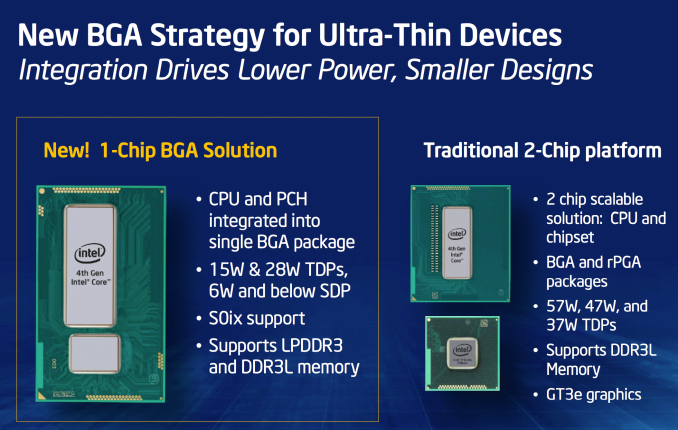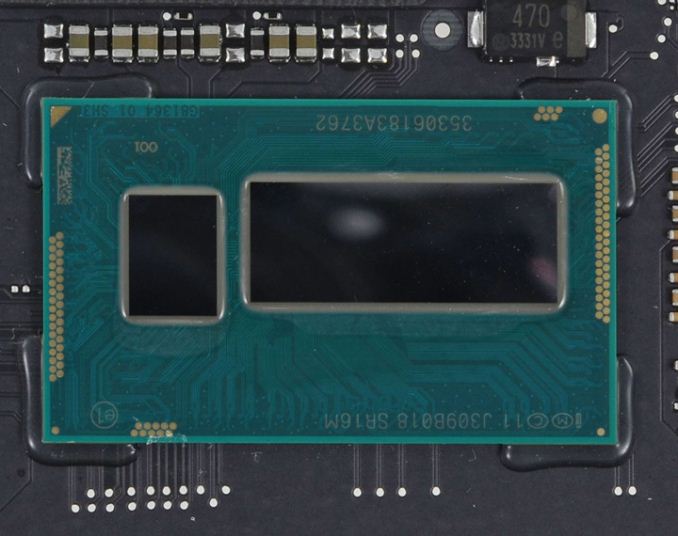The 2013 MacBook Air Review (13-inch)
by Anand Lal Shimpi on June 24, 2013 12:01 AM ESTThe CPUs
Apple keeps things simple across the 2013 MacBook Air lineup by configuring both 11 and 13-inch models with the same base CPU: a Core i5-4250U.
To understand Apple’s CPU choice, you have to understand that Apple is primarily concerned about improving battery life this generation. The line between MacBook Air and MacBook Pro has to be well defined. The Air is about portability, while the Pro is about performance. When faced with a power/performance tradeoff, it’s clear on which side of the fence Apple will fall whenever the MacBook Air is concerned.
| Apple 2013 MacBook Air CPU Comparison | |||||
| 1.3GHz dual-core | 1.7GHz dual-core | ||||
| Standard On | 11 & 13-inch MBA | Optional on Both | |||
| Intel Model | Core i5-4250U | Core i7-4650U | |||
| Base Clock Speed | 1.3GHz | 1.7GHz | |||
| Max SC Turbo | 2.6GHz | 3.3GHz | |||
| Max DC Turbo | 2.3GHz | 2.9GHz | |||
| L3 Cache | 3MB | 4MB | |||
| TSX-NI | No | Yes | |||
| TXT | No | Yes | |||
| AES-NI | Yes | Yes | |||
| VT-x/VT-x EPT | Yes | Yes | |||
| VT-d | Yes | Yes | |||
| TDP | 15W | 15W | |||
| Processor Graphics | Intel HD 5000 | Intel HD 5000 | |||
| GPU Clock (Base/Max) | 200/1000MHz | 200/1100MHz | |||
The lower base clock alone shouldn’t mean much, but the max TDP of the CPUs in the new MacBook Air falls as well - from 17W down to 15W. The thermal limit is even more dramatic since with Haswell ULT, the 15W includes the CPU/GPU as well as the on-package PCH. In Ivy Bridge the PCH was off package and wasn’t included in the 17W TDP.
Max turbo clocks are identical between the Haswell ULT CPUs Apple picked this round and the Ivy Bridge models before, but with a lower TDP it’ll be harder to always sustain the same frequencies given the right workload.
Haswell does feature a not insignificant gain in IPC compared to Ivy Bridge, which should help offset the power constraints that could otherwise force a larger regression in performance.
Both 2013 MBAs ship with the same CPU by default, and both can be upgraded to the same higher end SKU: a Core i7-4650U. The 4650U retains the same 15W TDP as the i5-4250U, but it increases its base clock speed to 1.7GHz and max turbo to 3.3GHz. The L3 cache also grows from 3MB to 4MB. All in all, this should be a very healthy upgrade in performance. Intel likely maintains the same TDP by binning for power; the i7-4650U is probably capable of running at higher frequencies without any appreciable increase in voltage. The max GPU clock also goes up by 10%.
Haswell ULT, Courtesy iFixit
What's arguably coolest about the i7-4650U is it enables Haswell's Transactional Synchronization Extensions (TSX-NI), a feature which is unfortunately disabled on the i5-4250U. I don't suspect this will matter much for most MBA users, but anyone looking to play around with Haswell's TSX instructions will want to opt for the higher end SKU. The upgrade costs $150 regardless of base model. Intel charges $454 for the i7-4650U and $342 for the i5-4250U, a difference of $112; Apple is adding another $38 onto the 1KU pricing, which isn't unreasonable.
Many have asked me what the impact of the i7 will be on battery life. I'm hoping to get my hands on an i7 based machine when I return from the UK in a week, but for those of you making immediate decisions I'll offer the following. Sustained operation at higher frequencies will likely draw more power, and negatively impact battery life. Light to medium workloads will enjoy a mix of race to sleep benefits as well as higher power consumption under load. Idle power should be roughly similar between the parts however. For most workloads I'd expect a modest impact to battery life, but it won't be enough to regress to 2012 levels of battery life. All of this is said without knowing key details like operating voltage for most 4650Us. I plan on addressing that shortly.












233 Comments
View All Comments
airmantharp - Monday, June 24, 2013 - link
I'd prove that LG makes a better screen than Samsung- but it's already been proven.Malih - Monday, June 24, 2013 - link
The laptop focuses on being lightweight, thus thin, thus limited battery capacity,and limited battery capacity doesn't play well with high res display,
They could choose to increase resolution with haswell and keep the same battery life, but seeing as they chose battery shows where they are focusing with Air.
That means if you want high res display, then get Retina MBP instead.
airmantharp - Monday, June 24, 2013 - link
Your iPhone would like to have a talk with you.seapeople - Tuesday, June 25, 2013 - link
And tell you about what? It's similar display resolution?abazigal - Monday, June 24, 2013 - link
You can always pay more to have the air ship with more ram.darwinosx - Monday, June 24, 2013 - link
Or faster procs or more sad.Strulf - Monday, June 24, 2013 - link
Yep, 8 GB are possible. In the generation before already.MatthiasP - Monday, June 24, 2013 - link
The resolution is quite OK if you consider the battery life and weight you get. Also both displays still offer a higher DPI than what you can get on the best desktop displays. What is really disappointing is the lack of an IPS panel. There is no excuse for that on a mobile device.Exelius - Monday, June 24, 2013 - link
8gb is available as a BTO option. I have a 11" 2012 MBP with an i7-3667U and 8gb RAM and it's more than enough for running a VM and even for doing some database work. Honestly, the machine is still mostly bound by the speed of the SSD for every workload I use it for. I love the size of the 11".The only complaint I have is that the GPU is a bit anemic, which the Haswell update seems to have addressed. I find that the 2012 Air has some noticeable jerkiness driving a 1080p display in OS X, which I suspect is a large part of the reason that the Airs haven't had a larger display. Hopefully, with that limitation removed, Apple can start to put some higher resolution displays in these machines over the next year or two.
darwinosx - Monday, June 24, 2013 - link
Read the article you are commenting on. 1400 X 900.You can get this laptop with 8 GB of you want.
1600 X 900 is to high for a 13 inch for most people. Tiny icons and text. Thats why Apple goes all the way to retina display on their higher end laptops instead of some half measure that won't satisfy anyone.
Dell makes junk and fails to support it. People looking at Mac's aren't going to consider a Dell with Microsoft's latest mediocrity of an OS.
This is of course a premium product in build quality, quality control, service and support, custom components like the ssd and battery. Not some plastic Dell with the cheapest possible parts they could get out of China this week.
Despite that retail starts at $1099 and they can be found cheaper online. Show me a PC laptop even close to this price, build, customizations and certainly service and support. How about a PC laptop with a working trackpad...
If you want a higher res screen and 8 GB out of the box thats the 13" retina. A new version of it is coming shortly and will be thinner and lighter than the current model.